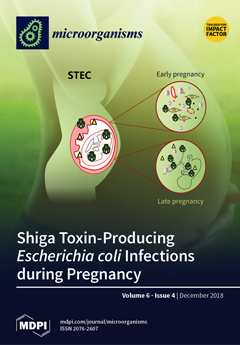Ver ítem
- xmlui.general.dspace_homeCentros e Institutos de InvestigaciónCICVyA. Centro de Investigación en Ciencias Veterinarias y AgronómicasInstituto de BiotecnologíaArtículos científicosxmlui.ArtifactBrowser.ItemViewer.trail
- Inicio
- Centros e Institutos de Investigación
- CICVyA. Centro de Investigación en Ciencias Veterinarias y Agronómicas
- Instituto de Biotecnología
- Artículos científicos
- Ver ítem
Novel Effector Protein EspY3 of Type III Secretion System from Enterohemorrhagic Escherichia coli Is Localized in Actin Pedestals
Resumen
Enterohemorrhagic Escherichia coli (EHEC) and enteropathogenic Escherichia coli (EPEC) are attaching and effacing (A/E) pathogens, which translocate effector proteins to intestinal enterocytes through a type III secretion system (T3SS). T3SS and most of its effector proteins are encoded in a pathogenicity island called LEE. Recently, new effectors have been located outside the LEE. This study aimed to characterize EspY3, a novel non-LEE encoded T3SS
[ver mas...]
Enterohemorrhagic Escherichia coli (EHEC) and enteropathogenic Escherichia coli (EPEC) are attaching and effacing (A/E) pathogens, which translocate effector proteins to intestinal enterocytes through a type III secretion system (T3SS). T3SS and most of its effector proteins are encoded in a pathogenicity island called LEE. Recently, new effectors have been located outside the LEE. This study aimed to characterize EspY3, a novel non-LEE encoded T3SS effector of EHEC. EspY3 shares homology with SopD and PipB2 effector proteins of Salmonella’s T3SS-1 and T3SS-2, respectively. The presence of recombinant EspY3 in the supernatant samples demonstrated that EspY3 was secreted by the T3SS of EHEC and EPEC. Through infection assays, we demonstrated the translocation of EspY3 into Caco-2 cells by T3SS of EPEC. The subcellular localization of EspY3 was determined in the pedestal region, where its presence generates a significant increase in the size of the pedestals area. The EspY3 effector induced the elongation of polymerized actin pedestals in infected Caco-2 by EPEC. This study confirmed that EspY3 is part of the repertoire of T3SS effectors of EHEC O157:H7, and that it participates in modeling cellular actin during the infection
[Cerrar]

Autor
Fuente
Microorganisms 6 (4) : 112. (2018)
Fecha
2018
Editorial
MDPI AG
ISSN
2076-2607
Formato
pdf
Tipo de documento
artículo
Palabras Claves
Derechos de acceso
Abierto
 Excepto donde se diga explicitamente, este item se publica bajo la siguiente descripción: Creative Commons Attribution-NonCommercial-ShareAlike 2.5 Unported (CC BY-NC-SA 2.5)
Excepto donde se diga explicitamente, este item se publica bajo la siguiente descripción: Creative Commons Attribution-NonCommercial-ShareAlike 2.5 Unported (CC BY-NC-SA 2.5)


